Politics
Shifting to traditional homeless shelters, de Blasio faces backlash from locals
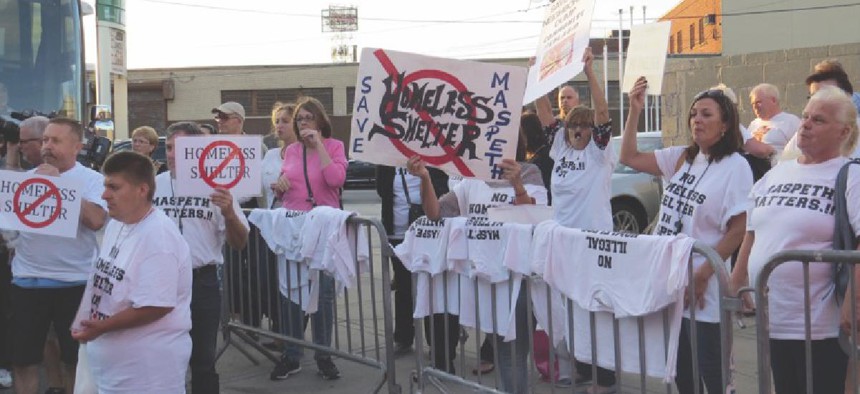
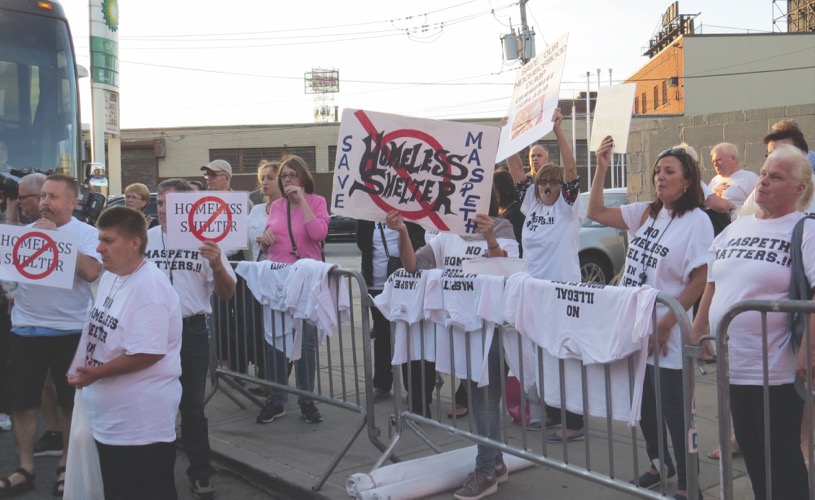
Residents of Maspeth, Queens protest a planned shelter in their neighborhood. Weeks later, the shelter plans were shelved by the de Blasio administration. (Sarina Trangle)
Packed onto a large commercial bus bound for a protest, dozens of passengers chanted about the politicians who had failed to halt a planned homeless shelter in Maspeth, Queens. They gleefully shouted about the September primary loss of their long-time assemblywoman, Margaret Markey. “No more Markey!” they chanted. And as the bus drove toward the Brooklyn home of the commissioner overseeing the city’s homeless services, they turned their attention to his boss, Mayor Bill de Blasio. “One-term mayor!” they repeated.
Outside Social Services Commissioner Steven Banks’ Windsor Terrace home, about 150 people blared horns, blew whistles and bellowed about plans to convert the Maspeth Holiday Inn Express into a shelter for 115 all-adult families, while Banks’ neighbors spilled out onto their stoops to watch the spectacle.
One of the rally organizers, Robert Holden, told City & State the security plan for the facility made it seem like a giant, jail-like warehouse, one without the kitchens he believed were legally required. Holden said the city would have more luck with smaller houses that blend in with the neighborhood.
“You don’t warehouse the homeless. Let’s face it, we’ll gladly accept one- and two-family homes that will fit into our housing stock,” Holden said. “If you put them in a small room, what’s going to happen? They’re not going to get better. They’re going to go out into the community with their problems. It’s a recipe for disaster.”
Days after the protest, Banks said the Holiday Inn Express site in Queens would meet mandates for its targeted population of adult-only families. Weeks later, Banks said the property owner decided not to let the city use the entire hotel, but agreed to rent 30 rooms, where the administration placed 30 single and employed men. Although community opposition remained, the commissioner continued to recite statistics showing the city does not have the luxury of prioritizing neighborhood preferences and perceived shelter shortcomings. New York City officials are grappling with an explosion in homelessness and their legal obligation to provide shelter for all who need of it. Over the past two decades, homelessness has increased by 115 percent, and an all time-high of nearly 60,000 people stay in city shelters.
Traditionally, the city has contracted with nonprofits to run Tier II shelters, which meet state guidelines for housing 10 or more families in private rooms and providing three nutritional meals a day, child care, health services and help preparing for permanent housing. Over the years, the city has also partnered with nonprofit-run shelters that follow this traditional model, but did not formally get the state Tier II designation. The city has also used hotels, booking rooms for the homeless in establishments that remain open to the general public and converting other hotels into more permanent shelters that provide needed services.
Additionally, the city has rented private apartments for homeless families. When using these so-called cluster sites, the city tasks social service providers with helping the families, though they may have to travel to meet case managers, social workers and others paid to help them.
“There are some communities that have more shelters. There are some that have either none or very few. I suspect that to the extent that there are communities that have political influence, they are able to react in a way that results in less development.”
-Frederick Shack, CEO of Urban Pathways
Despite a consensus that booking hotel rooms or renting private apartments for the homeless is a poor substitute for traditional shelters, architects of today’s shelter system did not dramatically shift away from those tactics while expanding to accommodate demand during the past dozen years. This lack of evolution has fueled speculation that the city’s reliance on the private market has been a way to avoid the drawn-out and politically-fraught battles sometimes stirred by opening a Tier II shelter.
The de Blasio administration has pledged to steer the city’s portfolio toward these more traditional models while phasing out its use of apartments and hotels. This shift, however, has not been well-received by a number of communities where new shelters are proposed. And as opposition mounts, some politicians say City Hall’s lack of collaboration and poor communication with them and their constituents has hindered its reform efforts.
Apart from a surge in the number of private apartments rented for homeless families, the makeup of the family shelter system has not changed significantly over the past 13 years for which City & State was able to find comparable data. (The city has not consistently tracked what types of homeless facilities were used for single adults.)
Between 2003 and 2006, the city’s use of cluster sites appeared to drop off, as apartments went from 20.6 percent of shelter units available to families to just 3.4 percent. By 2016, apartment use was back up, comprising about 22.6 percent of the system. During that period, Tier II units never accounted for much more than half of family shelters, and hotel units hovered between 21.2 and 28.2 percent of the system. The figures were pulled from two data sources: the department’s historical critical activities reports and its current shelter repair scorecard system. When asked to comment on the figures, the city Department of Homeless Services responded that it could not confirm them.
The figures likely do not represent all shelters, given that some operators are paid daily rates to house the homeless on an as-needed basis, which are unlikely to be accounted for in the city’s reporting. The city has also relied on emergency contracts, which may not be included, either.
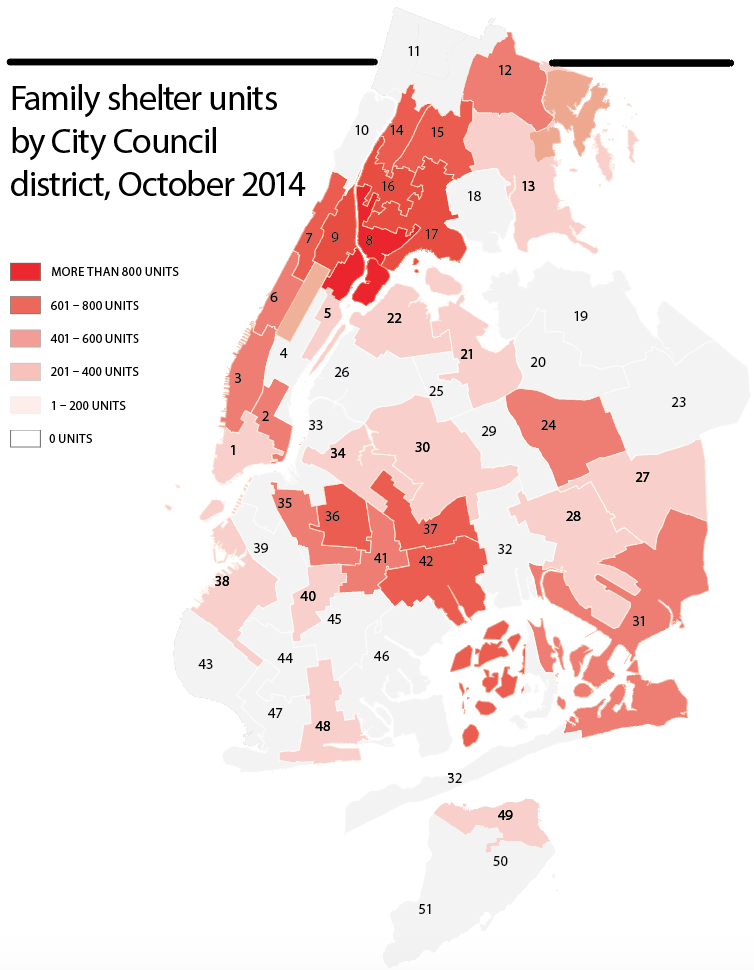
Source: All information taken from an Oct. 2014 report by the Institute for Children, Poverty & Homelessness. The institute's President and CEO Ralph da Costa Nunez said in an interview that his team could not locate all city shelters open at any single point in time, and estimated its research accounted for 63 percent of the shelters at the time.
For years, these unorthodox procurement practices of paying landlords per-diem rates and issuing emergency contracts for shelter have been criticized as fiscally irresponsible and as prone to finding poorly maintained spaces. As early as 2003, then-City Comptroller William Thompson Jr. raised concerns about the city not signing contracts with shelter operators and about safety concerns in their facilities.
A decade later, City Comptroller John Liu, Thompson’s successor, detailed how few shelters went through the traditional land use review process. His office said arrangements meant to temporarily provide the city with flexibility, like paying nightly per-diem rates or issuing a contract under an emergency declaration, had become a de facto path to establishing permanent shelters.
As recently as 2015, the city Department of Investigation released a report showing these expensive practices left DHS with fewer options to financially penalize negligent landlords or to contractually obligate them to address problems. The city was paying an average monthly rate of $2,840 for each family in a hotel, which often had building and fire code violations, according to the Department of Investigation. And the city spent an average of $2,451 a month to put families in private apartment buildings where the market monthly rent ranged from $528 to $1,200. Besides the markup, the report found cluster sites were the worst maintained and did not consistently connect homeless families with the case management services they needed.
Setting aside concerns about the quality and availability of such services, some experts say there can be political advantages to using hotels and private apartments. Opening a Tier II shelter is a more time-consuming process, and communities tend to be be more aware of the proposal – and have more time to try to thwart it. These traditional shelters are also a more visible reminder of homelessness – and how well any given administration is handling it, according to Ralph da Costa Nunez, president of the Institute for Children, Poverty and Homelessness. The Bloomberg administration “didn’t want to have these more state-regulated facilities because it makes the issue much more visible,” de Costa Nunez said. “So they expanded the cluster sites and the hotel sites. And what’s happened is that became the norm. They’ll put people there because it’s easy. They’ll put people there because they really don’t always get counted.”
Having helped Mayor Ed Koch open shelters, de Costa Nunez said he knew how difficult it was to find available, appropriate spaces for homeless people. He said this made the city reluctant to back away from identified locations, even in the face of immense public resistance. De Costa Nunez said that only very rarely did the backlash reach a point that City Hall decided to drop its shelter plans. However, Josh Goldfein, an attorney with the Legal Aid Society’s Homeless Rights Project, said that he had heard of nonprofits getting pressured out of proposed sites.
Even supportive housing, which is generally viewed as more palatable because it provides long-term homes and stabilizing services, has fallen victim to community backlash. For instance, Frederick Shack, CEO of Urban Pathways, said that near the end of Bloomberg’s final term, the nonprofit was asked by the city agency providing funding for a supportive housing project in Riverdale to pull its application. “There are some communities that have more shelters. There are some that have either none or very few,” Shack said. “I suspect that to the extent that there are communities that have political influence, they are able to react in a way that results in less development.”
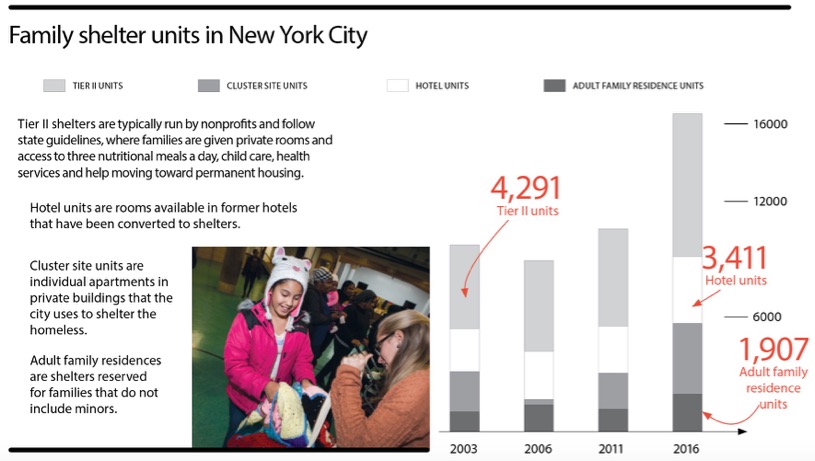
Even those who believe the shelter system has been shaped by politics acknowledge the de Blasio administration’s decisions are chiefly driven by an acute need for shelter space. Meeting this demand is so pressing that the city has had to go to extraordinary lengths to open shelters where they probably would have preferred not to, according to Catherine Trapani, executive director of Homeless Services United, a group representing nonprofit shelter and service providers. “When you need to open up a shelter immediately, commercial hotels are often the most expeditious thing to get online because the city can just master lease a block of rooms,” Trapani said.
And for years, a legal mandate to provide shelter to all who need it has overpowered local opposition, according to Giselle Routhier, policy director for the Coalition for the Homeless. “If you look back, over the de Blasio, over the Bloomberg administration and way back, I mean most of the time, if a shelter needs to be opened, it gets opened,” she said.
Banks said he could not speak to the motivation of past administrations, but that the city needs hotels and shelters so desperately that calls to reject them cannot be heeded. For instance, he said protesters who rallied last month against using hotels as shelters near the Queens-Long Island border would leave youths without a roof over their heads. “That’s not a result that we can have, particularly for young children, who would end up on the streets,” he said.
Philosophically, the de Blasio administration agrees with those arguing against putting the homeless in hotel rooms and has pledged to eventually stop this practice. But Banks said hotel rooms fill a crucial need as the city recalibrates its shelter system. Based on what Banks called the first review of the homeless system in two decades, the city announced it would phase out its use of cluster sites by the end of 2018. The commissioner said DHS prioritized pulling out of cluster sites because reserving them for homeless families exacerbates the shortage of low-rent apartments partially fueling the homelessness crisis.
“If you look back, over the de Blasio, over the Bloomberg administration and way back, I mean most of the time, if a shelter needs to be opened, it gets opened.”
-Giselle Routhier, policy director for the Coalition for the Homeless.
Building by building, Banks’ team has been attempting to convert cluster units into rental homes that are in good condition and made available to their most recent occupants. So far the city has shut down 250 cluster units, he said, while officials have identified another 295 for closure. Meanwhile, the city is working to expand the number of Tier II units and similar spaces by converting hotels into more permanent shelters run by nonprofits and by sorting through responses to a related request for proposal.
But in several communities where the city has sought out shelter space, local residents have not been quick to welcome the homeless. Jose Rodriguez, 53, a former substance abuse counselor whose health problems forced him to stop working, said the East Harlem community has shunned those in the shelter where he resides – and when police and neighbors treat the homeless like criminals, it only adds to their struggles. A local Chelsea newspaper reported that upset New Yorkers “chased” an assistant DHS commissioner out of a community board meeting. An Elmhurst resident who launched an effort to aid people in a controversial shelter had security escort him away from a protest, according to DNAinfo. Many outraged by shelters have complained that the city moves people in during the night.
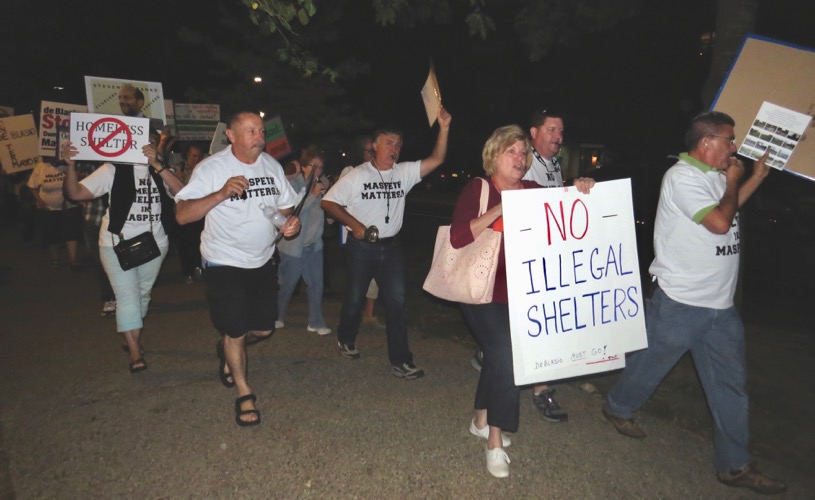
The residents of Maspeth, Queens, boarded a bus and continued protesting outside the home of city Social Services Commissioner Steven Banks in Windsor Terrace, Brooklyn. (Sarina Trangle)
Following the Department of Homeless Services review, Banks said the city has committed to giving communities at least 30 days notice before opening a space routinely used as a shelter. He said the city is also considering what notification steps it could take when an unanticipated shortage of shelter space compels officials to rent commercial hotel rooms. Beyond highlighting homeless New Yorkers’ needs and the city’s robust homelessness prevention efforts, Banks said the city has found community advisory boards helpful in dispelling concerns and weighing suggestions for shelters. He did not seem fazed by the furor displayed outside his home – or elsewhere. Rather, he said he has seen residents acclimate and accept shelters that were once controversial.
“When all of these facilities were opened, there were concerns raised and over the course of time, those facilities have become an integral part of the community in which they’re located. And that’s the story that repeats itself throughout time across the city,” he said. “I think ultimately New Yorkers want to help their fellow New Yorkers, and see it’s a citywide problem. That’s not to say that, as we proceed, there aren’t differences in opinion. And we try to address those concerns as we proceed.”
City Council Committee on General Welfare Chairman Stephen Levin said he has seen communities come around, too. Initially, Levin said he opposed a 200-bed assessment center planned in his north Brooklyn district. But since it opened, he said the organization running it has proven to be a strong community partner. And in his community, Levin said the Department of Homeless Services has helped integrate shelters by coming out to discuss plans and progress and by responding to residents’ requests for assistance, like extra peace officers.
But a number of elected officials complained about City Hall’s lack of collaboration and poor communication about shelter sitings. About a year ago, City Councilman Andrew Cohen said he advised the administration against sheltering the homeless in a Riverdale motel that once served as an institutional home for mentally ill adults. Despite saying they would not use the location, DHS moved homeless adults in without notifying Cohen, according to the councilman. “When you’re not communicating what the facts are, when there is a lot of mystery and speculation,” Cohen said, “that is undermining to the work that they’re trying to do.”
State Sen. Joseph Addabbo said he and other Queens officials were called to City Hall in 2014 and told they would be getting shelters in various locations because the borough had fewer shelters than its counterparts. The administration’s plans would have been more well received, he said, if City Hall worked with elected officials to find vacant properties, foreclosed homes and other locations to provide shelter. “It’s one state, so you call the governor and you say, ‘What else do we have? What state-owned properties or facilities do we have? … Where can we properly house these individuals in an area that may be lower cost of living?’ But this mayor can’t call the governor,” said Addabbo, who represents areas in Maspeth, Glendale and Ozone Park where shelters have been proposed. “A little more planning, and a little bit more cooperative effort would have addressed the problem much better.”
Banks said he fielded and reviewed alternative shelter locations suggested by Addabbo and his constituents, but their recommendations would not have helped the city meet its capacity needs before the winter. Maspeth residents were miffed that the city did not communicate with them about these insufficiencies.
Regardless of the perceived slight, many in Maspeth seem empowered by their unified opposition to the shelter and by the threat they believe they pose at the polls. Several elected officials said it is impossible to ever identify one issue as the decisive factor in an election. But they acknowledged that the proposed shelter likely played into the Assembly primary outcome.
And that has provided precedent enough for those in Maspeth.
“Markey’s the first casualty, but others will fall because of this,” Holden said. “I don’t want to have people come into my neighborhood and have all sorts of health problems – mental problems – and walk the streets of our neighborhood and endanger our city, our citizens. That’s a natural reaction – you’re seeing this from people from all over the city. And we’re going to band together.”

NEXT STORY: Hakeem Jeffries slams talk of successor to D.A. Thompson, says Gonzales should be given chance